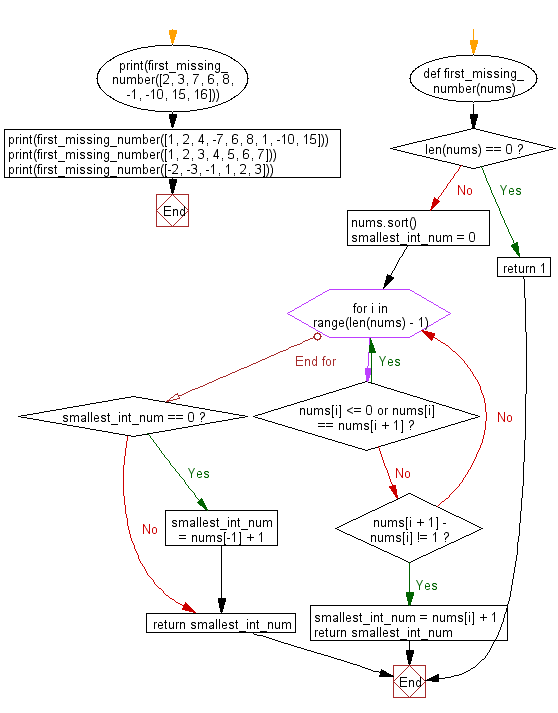Python: Find the first missing positive integer that does not exist in a given list
First Missing Positive Integer
Write a Python program to find the first missing positive integer that does not exist in a given list.
Sample Solution:
Python Code:
# Define a function to find the first missing positive integer in a list
def first_missing_number(nums):
# Check if the list is empty, return 1 if it is
if len(nums) == 0:
return 1
# Sort the list in ascending order
nums.sort()
# Initialize the smallest positive integer as 0
smallest_int_num = 0
# Iterate through the sorted list
for i in range(len(nums) - 1):
# Skip non-positive or duplicate numbers
if nums[i] <= 0 or nums[i] == nums[i + 1]:
continue
else:
# Check for a gap between consecutive numbers
if nums[i + 1] - nums[i] != 1:
smallest_int_num = nums[i] + 1
return smallest_int_num
# If no gap is found, the smallest missing positive integer is after the last element
if smallest_int_num == 0:
smallest_int_num = nums[-1] + 1
# Return the smallest missing positive integer
return smallest_int_num
# Test the function with different lists of numbers
print(first_missing_number([2, 3, 7, 6, 8, -1, -10, 15, 16]))
print(first_missing_number([1, 2, 4, -7, 6, 8, 1, -10, 15]))
print(first_missing_number([1, 2, 3, 4, 5, 6, 7]))
print(first_missing_number([-2, -3, -1, 1, 2, 3]))
Sample Output:
4 3 8 4
Explanation:
Here is a breakdown of the above Python code:
- The function "first_missing_number()" takes a list of numbers ('nums') as input.
- It checks if the list is empty and returns 1 if it is.
- The function sorts the list in ascending order.
- It initializes the smallest positive integer as 0.
- It iterates through the sorted list, skipping non-positive or duplicate numbers.
- It checks for a gap between consecutive numbers, indicating a missing positive integer.
- If a gap is found, the smallest missing positive integer is determined and returned.
- If no gap is found, the smallest missing positive integer is after the last element.
- The function is tested with different lists of numbers.
Flowchart:

For more Practice: Solve these Related Problems:
- Write a Python program to find the smallest missing positive integer in an unsorted array in O(n) time.
- Write a Python program to identify the first missing positive number by rearranging the array elements in-place.
- Write a Python program to determine the smallest positive integer that does not appear in a given list using index mapping.
- Write a Python program to compute the first absent positive number using a constant space solution.
Go to:
Previous: Write a Python program to compute the largest product of three integers from a given list of integers.
Next: Write a Python program to randomly generate a list with 10 even numbers between 1 and 100 inclusive.
Python Code Editor:
Have another way to solve this solution? Contribute your code (and comments) through Disqus.
What is the difficulty level of this exercise?
Test your Programming skills with w3resource's quiz.
